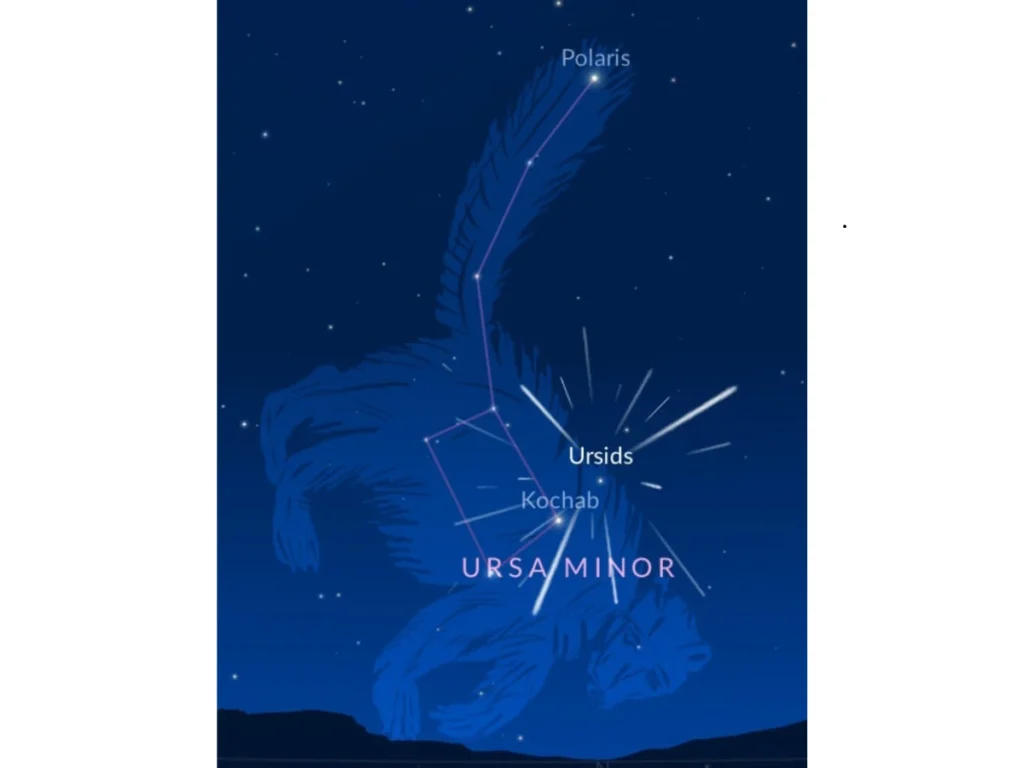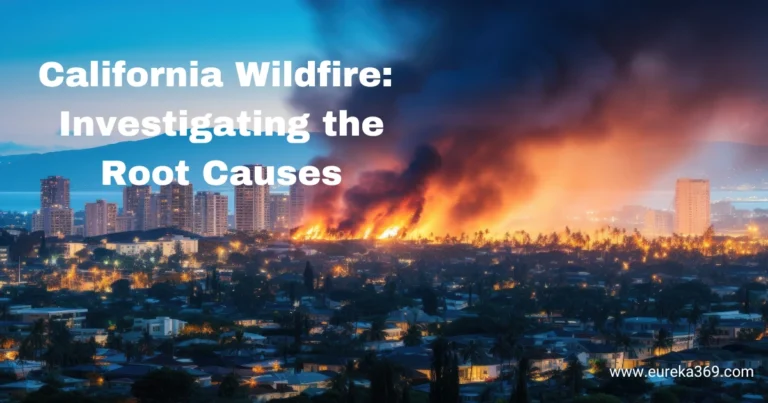
“The Ursid meteor shower has an intriguing history tied to its parent comet, which has been known by many names over the years.”
Overview of the Ursid Meteor Shower
Often overlooked during the busy holiday season, the Ursid meteor shower is a low-key event. Many people prioritize the Geminids shower, which takes place earlier in December, or their holiday plans for December 22. However, the Ursids offer a chance to see some meteors from a meteor stream that originates from the radiant near the North Star, in the northerly latitudes. Unlike the more intense meteor showers, the Ursids produce fewer meteors, typically around 5–10 meteors per hour.
When should I watch the Ursid Meteor Shower?
We predict that the Ursid shower will peak around midnight on December 23, with the best viewing times occurring from late night to early morning.
The moon phase of the last quarter moon can sometimes interfere with viewing, as it will be around 54% illuminated. The moon may block out some meteors, but still, dark sky conditions after dawn provide a clear opportunity to watch the event. If you’re in the right location, especially at circumpolar latitudes, you might see the Ursids in full action. At 5:22 UTC, the peak hours begin, offering an excellent chance to catch the meteor shower before it ends around December 24.
The Parent Comet of the Ursids
The Ursid meteor shower has an intriguing history tied to its parent comet, which has been known by many names over the years. The comet responsible for this meteor stream is Comet Tuttle (8P/Tuttle). Pierre Méchain first observed this periodic comet in 1790 in Paris, France. Charles Messier later confirmed the comet’s orbit, noting it as one of the many comets they were tracking.
The comet itself is closely associated with the name Johann Encke, whose work on Comet Encke helped improve understanding of the periodic nature of comets. Comet Tuttle’s periodicity is fascinating, returning every 68 years. The comet’s closest approach to the sun occurred on January 5, 1858, when it passed through the inner solar system.
Comet Tuttle’s orbit intersects Earth’s path in the early 2000s, specifically in August 2021, resulting in meteor shower outbursts and an increase in meteor activity. Comet Tuttle’s path tilts relative to the solar system’s plane, allowing the meteor stream to spread out in multiple directions.
This interaction between Earth and the comet produces occasional shower outbursts, which have caused a boost in the number of meteors seen in the Ursid shower. Comet Tuttle, or Periodic Comet Mechain-Tuttle, has remained an important object of study, with astronomers continuing to track its return to better understand the material that creates these meteor showers. Its next expected return is likely to cause more Ursid meteor activity, potentially outshining the usual event, bringing added excitement in December.
Viewing the Ursid Meteor Shower in 2024
“The Ursid meteor shower in 2024 offers a rare chance to observe meteors, especially for those in the Northern Hemisphere. Expect the best viewing times around midnight, especially from December 21 to December 22, when the shower reaches its peak.”
During these hours, you can expect to see between 5 to 10 meteors per hour under a dark sky. Although the Ursids are not as intense as other meteor showers, you may see 100 meteors in an hour during bursts.
To fully enjoy the Ursid meteor shower, you need to plan ahead. Meteor-watchers should find a location away from city lights, such as an open field or a remote country area. As the weather is often cold in December, it is essential to dress warmly and consider bringing a sleeping bag for comfort. You can also set up in a vehicle or building if you’re looking for shelter while reclining under the starry sky. With the December solstice approaching, be sure to start watching before dawn to maximize your chances of witnessing this annual event. Check out on YouTube: Ursid Meteor Shower 2024| Mesmerizing Sky Show or watch below:
Radiant Point of the Ursid Meteor Shower
The Ursid meteor shower has its radiant point near the Big Dipper, which is part of the Ursa Major constellation. From the Northern Hemisphere, the meteors appear to come from the north-northeast, near Polaris, the North Star, in the Ursa Minor constellation. This is a circumpolar region, meaning it is visible year-round from far-northerly latitudes such as Canada. The meteors in this shower are typically slow-moving and can sometimes leave long, bright streaks across the sky. As the solstice approaches, the best time to see them is after nightfall and before dawn, especially around 1 a.m. local time.

It’s helpful to look toward the radiant point when watching the Ursid meteor shower, but you can see the meteors in various paths across the sky. The shower is known for producing occasional fireballs, some even showing up as a green hue. One memorable image from December 20, 2019, captured a bright meteor streaking across the sky in Lindon, Colorado, creating a brilliant light over the eastern plains. If you’re in a location with a clear, dark sky, using tools like the EarthSky Planisphere can help guide your stargazing efforts. Even if you don’t see the radiant point, the meteors will be streaking in all directions, making the experience enjoyable for any stargazer.
History of the Ursid Meteor Shower
The Ursid meteor shower is relatively new compared to more famous showers like the Perseids, which have been observed for centuries. Often overlooked, the Ursids have gained more prominence in recent years. The shower’s radiant point lies near Kochab, a star in the Little Dipper, which is part of the bowl of the asterism. The meteors in this shower have a random direction of motion, but they appear to radiate from the dome of the sky. Most people in the Northern Hemisphere can see these meteors after nightfall.
Ursid outbursts have been rare but fascinating when they do occur, with some years producing bursts of up to 100 meteors per hour. This has happened in the past, such as in 1945, 1986, and 1973, when observers noticed a significant increase in activity. These outbursts can include fireballs and bright streaks across the sky. For example, Eliot Herman in Tucson, Arizona, captured a stunning fireball on December 18, 2016, a remarkable sight for skywatchers. Over the years, the Ursid meteor shower has gained more popularity due to these occasional bursts, making it an exciting event for those interested in observing meteors.
Ideal views for the Northern Hemisphere
The Northern Hemisphere, where the radiant point is near Kochab, a star in the Little Dipper, is the best place to observe the Ursid meteor shower. From this vantage point, you can see meteors streaking in different directions, all appearing to radiate from the north. As the shower peaks on December 22, 2024, the last quarter moon will block some of the light, but dark sky conditions after midnight will provide an excellent opportunity for stargazing. Major action occurs on the northern horizon, and meteors radiate outward.
For the best experience, choose a country location or camp in a place free from city lights, especially in temperate latitudes. Make sure to dress warmly and bring a blanket or reclining chair to enjoy the starry sky comfortably. Peak times for the Ursid meteor shower vary, but typically, the best viewing will occur between December 21 and December 22. According to the American Meteor Society, these conditions make the shower particularly ideal for meteor-watchers in the Northern Hemisphere.

Final words
The Ursid meteor shower may not be as famous as other annual meteor showers, but it offers a unique and peaceful opportunity for sky watchers, especially in the Northern Hemisphere. With its slow-moving meteors and occasional bursts of activity, it provides a quiet alternative to the more intense showers. Whether you are camping under the starry sky or watching from your backyard, the Ursids offer a memorable experience during the holiday season. With clear skies and a bit of patience, you can enjoy this rare celestial event that reaches its peak around December 22, 2024.
I also highly recommend to check out an intriguing factors behind Nova explosions which will truly amaze you. Nova Explosion: Exploring the 8 Intriguing Factors behind it



Leave a Reply